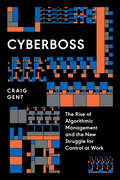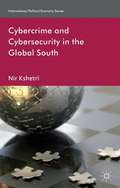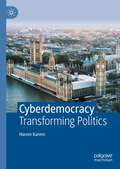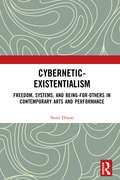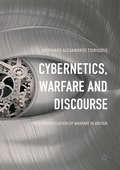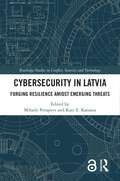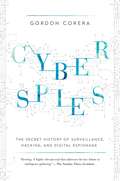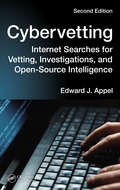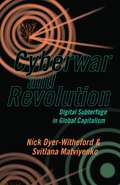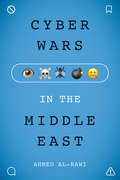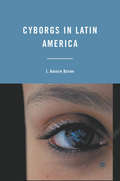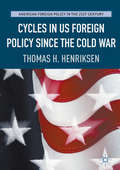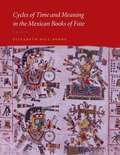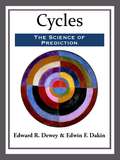- Table View
- List View
Cyber-Security and Threat Politics: US Efforts to Secure the Information Age (CSS Studies in Security and International Relations)
by Myriam Dunn CaveltyThis book explores the political process behind the construction of cyber-threats as one of the quintessential security threats of modern times in the US. Myriam Dunn Cavelty posits that cyber-threats are definable by their unsubstantiated nature. Despite this, they have been propelled to the forefront of the political agenda. Using an innovative theoretical approach, this book examines how, under what conditions, by whom, for what reasons, and with what impact cyber-threats have been moved on to the political agenda. In particular, it analyses how governments have used threat frames, specific interpretive schemata about what counts as a threat or risk and how to respond to this threat. By approaching this subject from a security studies angle, this book closes a gap between practical and theoretical academic approaches. It also contributes to the more general debate about changing practices of national security and their implications for the international community.
Cyberactivism: Online Activism in Theory and Practice (Routledge Studies In New Media And Cyberculture Ser.)
by Martha McCaughey Michael D. AyersCyberactivism is a timely collection of essays examining the growing importance of online activism. The contributors show how online activists have not only incorporated recent technology as a tool for change, but also how they have changed the meaning of activism, what community means, and how they conceive of collective identity and democratic change. Topics addressed range from the Zapatista movement's use of the web to promote their cause globally to the establishment of alternative media sources like indymedia.org to the direct action of "hacktivists" who disrupt commercial computer networks. Cyberactivism is essential reading for anyone interested in understanding the impact of the Internet on politics today.
Cyberboss: The Rise of Algorithmic Management and the New Struggle for Control at Work
by Craig GentHow technologies of organization are redrawing the lines of class struggleAcross the world, algorithms are changing the nature of work. Nowhere is this clearer than in the logistics and distribution sectors, where workers are instructed, tracked and monitored by increasingly dystopian management technologies.In Cyberboss, Craig Gent takes us into workplaces where algorithms rule to excavate the politics behind the newest form of managerial power. Combining worker testimony and original research on companies such as Amazon, Uber, and Deliveroo, the cutting edge of algorithmic management technology, this book reveals the sometimes unexpected effects these new techniques have on work, workers and managers. Gent advances an alternative politics of resistance in the face of digital control.
Cybercrime and Cybersecurity in the Global South
by Nir KshetriIntegrating theories from a wide range of disciplines, Nir Kshetri compares the patterns, characteristics and processes of cybercrime activities in major regions and economies in the Global South such as China, India, the former Second World economies, Latin America and the Caribbean, Sub-Saharan Africa and Middle East and North Africa.
Cyberdemocracy: Transforming Politics
by Harem KaremThis book is explicitly modernist at a time when many scholars have either forgotten the emancipatory promise of the Enlightenment or railed against it in the name of postmodernism. The book, broadly, adopts a hybrid epistemology that utilises the critical insights of Geisteswissenschaften Tradition (Weberian ‘Ideal-Type Analysis’) and the Habermas (1988) notions of the ‘public sphere’ and deliberative/dialogic democracy (‘ideal speech’) to advance a general proposition of democratic renewal by way of cyberdemocracy. Curiously, as democracy spreads across the world in the age of globalisation, it has also been accompanied by increased discontent with democratic systems. To that end, this book is not overly concerned with saving democracy beyond the liberal representative model, rather the focus is on how modern representative democracy has failed and how cyberdemocracy might function as a more effective model that truly represents the people by broadening participation and reflexive deliberation.
Cybernetic Revolution and Global Aging: Humankind on the Way to Cybernetic Society, or the Next Hundred Years (World-Systems Evolution and Global Futures)
by Leonid Grinin Andrey Korotayev Anton GrininThis book explores the global technological transformations that have shaped development of society for eons, from the emergence of Homo sapiens to the modern day. Looking at a potential future for all of this century and the beginning of the next, the book explores how society is changing as a result of the two most powerful trends: technological advances and global aging. It studies the forthcoming technological wave – the Cybernetic Revolution, which will encompass AI, medical technology and biotechnology, robotics, cognitive, nanotechnology etc. In turn, it shows why and how global aging will become one of the most powerful factors, influencing the evolution of society and the World System as a whole. Lastly, the book demonstrates how technological innovations can change the way people live and the society of the future, assessing both the new opportunities and threats posed by uncontrolled technological progress. Accordingly, it will appeal to social scientists, political scientists, economists and historians who are interested in technological transformations and their social and economic impacts.
Cybernetic Revolutionaries
by Eden MedinaIn Cybernetic Revolutionaries, Eden Medina tells the history of two intersecting utopian visions, one political and one technological. The first was Chile's experiment with peaceful socialist change under Salvador Allende; the second was the simultaneous attempt to build a computer system that would manage Chile's economy. Neither vision was fully realized--Allende's government ended with a violent military coup; the system, known as Project Cybersyn, was never completely implemented--but they hold lessons for today about the relationship between technology and politics. Drawing on extensive archival material and interviews, Medina examines the cybernetic system envisioned by the Chilean government--which was to feature holistic system design, decentralized management, human-computer interaction, a national telex network, near real-time control of the growing industrial sector, and modeling the behavior of dynamic systems. She also describes, and documents with photographs, the network's Star Trek-like operations room, which featured swivel chairs with armrest control panels, a wall of screens displaying data, and flashing red lights to indicate economic emergencies. Studying project Cybersyn today helps us understand not only the technological ambitions of a government in the midst of political change but also the limitations of the Chilean revolution. This history further shows how human attempts to combine the political and the technological with the goal of creating a more just society can open new technological, intellectual, and political possibilities. Technologies, Medina writes, are historical texts; when we read them we are reading history.
Cybernetic Revolutionaries: Technology and Politics in Allende's Chile
by Eden MedinaA historical study of Chile's twin experiments with cybernetics and socialism, and what they tell us about the relationship of technology and politics.In Cybernetic Revolutionaries, Eden Medina tells the history of two intersecting utopian visions, one political and one technological. The first was Chile's experiment with peaceful socialist change under Salvador Allende; the second was the simultaneous attempt to build a computer system that would manage Chile's economy. Neither vision was fully realized—Allende's government ended with a violent military coup; the system, known as Project Cybersyn, was never completely implemented—but they hold lessons for today about the relationship between technology and politics.Drawing on extensive archival material and interviews, Medina examines the cybernetic system envisioned by the Chilean government—which was to feature holistic system design, decentralized management, human-computer interaction, a national telex network, near real-time control of the growing industrial sector, and modeling the behavior of dynamic systems. She also describes, and documents with photographs, the network's Star Trek-like operations room, which featured swivel chairs with armrest control panels, a wall of screens displaying data, and flashing red lights to indicate economic emergencies.Studying project Cybersyn today helps us understand not only the technological ambitions of a government in the midst of political change but also the limitations of the Chilean revolution. This history further shows how human attempts to combine the political and the technological with the goal of creating a more just society can open new technological, intellectual, and political possibilities. Technologies, Medina writes, are historical texts; when we read them we are reading history.
Cybernetic-Existentialism: Freedom, Systems, and Being-for-Others in Contemporary Arts and Performance
by Steve DixonCybernetic-Existentialism: Freedom, Systems, and Being-for-Others in Contemporary Arts and Performance offers a unique discourse and an original aesthetic theory. It argues that fusing perspectives from the philosophy of Existentialism with insights from the ‘universal science’ of cybernetics provides a new analytical lens and deconstructive methodology to critique art. In this study, Steve Dixon examines how a range of artists’ works reveal the ideas of Existentialist philosophers including Kierkegaard, Camus, de Beauvoir, and Sartre on freedom, being and nothingness, eternal recurrence, the absurd, and being-for-others. Simultaneously, these artworks are shown to engage in complex explorations of concepts proposed by cyberneticians including Wiener, Shannon, and Bateson on information theory and ‘noise’, feedback loops, circularity, adaptive ecosystems, autopoiesis, and emergence. Dixon’s groundbreaking book demonstrates how fusing insights and knowledge from these two fields can throw new light on pressing issues within contemporary arts and culture, including authenticity, angst and alienation, homeostasis, radical politics, and the human as system.
Cybernetics, Warfare and Discourse: The Cybernetisation of Warfare in Britain
by Anthimos Alexandros TsirigotisThis book critiques mainstream beliefs about cyberwarfare and forges a new path in the way of defining this largely misunderstood concept. Rather than outlining cyberspace as a new technology applied in military operations, here, Tsirigotis rallies against this technocentric account and establishes how cyberspace, first and foremost, should be categorized as a new way to understand war and military power in the Information Age. Using genre analysis and Corpus Linguistics, the author scrutinizes how cyberspace has changed the way the UK comprehends war and military power, and how the cybernetisation of war has manifested itself in Britain's approach to national defense and security.
Cybersecurity in Latvia: Forging Resilience amidst Emerging Threats (Routledge Studies in Conflict, Security and Technology)
by Mihails Potapovs Kate E. KanastaDrawing on expertise from professionals, government officials, and academics, this book uncovers the proactive measures taken by Latvia to build resilient cybersecurity capabilities.The work offers a comprehensive exploration of Latvia’s cyber domain, structured around three overarching themes: the ecosystem, its processes, and future perspectives. In doing so, it takes readers through the intricacies of Latvia’s cybersecurity landscape and provides a nuanced understanding of its strengths, challenges, strategic considerations, and broader implications. One of the key contributions of the work lies in its exploration of Latvia’s cybersecurity strategies and resilience. By delving into the nation’s policies, collaborations, and technological advancements, this book uncovers how Latvia has proactively addressed cyber threats, emphasising the importance of tailored approaches for smaller countries in building robust cybersecurity defences. Highlighting the importance of studying cybersecurity in smaller nations, this book stresses Latvia’s contributions to global cybersecurity efforts as an EU and NATO member. The volume advocates for innovation and collaboration, emphasising their crucial role in securing a digital future for nations worldwide.This book will be of much interest to student of cybersecurity, Baltic politics, EU politics, global governance, and International Relations.The Open Access version of this book, available at http://www.taylorfrancis.com, has been made available under a Creative Commons Attribution-Non Commercial-Share Alike (CC-BY-NC-SA) 4.0 license.
Cyberspies: The Secret History of Surveillance, Hacking, and Digital Espionage
by Gordon CoreraThe previously untold--and previously highly classified--story of the conflux of espionage and technology, with a compelling narrative rich with astonishing revelations taking readers from World War II to the internet age. As the digital era become increasingly pervasive, the intertwining forces of computers and espionage are reshaping the entire world; what was once the preserve of a few intelligence agencies now affects us all. Corera's compelling narrative takes us from the Second World War through the Cold War and the birth of the internet to the present era of hackers and surveillance. The book is rich with historical detail and characters, as well as astonishing revelations about espionage carried out in recent times by the UK, US, and China. Using unique access to the National Security Agency, GCHQ, Chinese officials, and senior executives from some of the most powerful global technology companies, Gordon Corera has gathered compelling stories from heads of state, hackers and spies of all stripes. Cyberspies is a ground-breaking exploration of the new space in which the worlds of espionage, diplomacy, international business, science, and technology collide.
Cybervetting: Internet Searches for Vetting, Investigations, and Open-Source Intelligence, Second Edition
by Edward J. AppelResearching an individual‘s, firm‘s or brands online presence has become standard practice for many employers, investigators, and intelligence officers, including law enforcement. Countless companies and organizations are implementing their own policies, procedures, and practices for Internet investigations, cybervetting, and intelligence.
Cyberwar and Revolution: Digital Subterfuge in Global Capitalism
by Svitlana Matviyenko Nick Dyer-WithefordUncovering the class conflicts, geopolitical dynamics, and aggressive capitalism propelling the militarization of the internet Global surveillance, computational propaganda, online espionage, virtual recruiting, massive data breaches, hacked nuclear centrifuges and power grids—concerns about cyberwar have been mounting, rising to a fever pitch after the alleged Russian hacking of the U.S. presidential election and the Cambridge Analytica scandal. Although cyberwar is widely discussed, few accounts undertake a deep, critical view of its roots and consequences. Analyzing the new militarization of the internet, Cyberwar and Revolution argues that digital warfare is not a bug in the logic of global capitalism but rather a feature of its chaotic, disorderly unconscious. Urgently confronting the concept of cyberwar through the lens of both Marxist critical theory and psychoanalysis, Nick Dyer-Witheford and Svitlana Matviyenko provide a wide-ranging examination of the class conflicts and geopolitical dynamics propelling war across digital networks.Investigating the subjectivities that cyberwar mobilizes, exploits, and bewilders, and revealing how it permeates the fabric of everyday life and implicates us all in its design, this book also highlights the critical importance of the emergent resistance to this digital militarism—hacktivism, digital worker dissent, and off-the-grid activism—for effecting different, better futures.
Cyberwars in the Middle East (War Culture)
by Ahmed Al-RawiCyberwars in the Middle East argues that hacking is a form of online political disruption whose influence flows vertically in two directions (top-bottom or bottom-up) or horizontally. These hacking activities are performed along three political dimensions: international, regional, and local. Author Ahmed Al-Rawi argues that political hacking is an aggressive and militant form of public communication employed by tech-savvy individuals, regardless of their affiliations, in order to influence politics and policies. Kenneth Waltz’s structural realism theory is linked to this argument as it provides a relevant framework to explain why nation-states employ cyber tools against each other. On the one hand, nation-states as well as their affiliated hacking groups like cyber warriors employ hacking as offensive and defensive tools in connection to the cyber activity or inactivity of other nation-states, such as the role of Russian Trolls disseminating disinformation on social media during the US 2016 presidential election. This is regarded as a horizontal flow of political disruption. Sometimes, nation-states, like the UAE, Saudi Arabia, and Bahrain, use hacking and surveillance tactics as a vertical flow (top-bottom) form of online political disruption by targeting their own citizens due to their oppositional or activists’ political views. On the other hand, regular hackers who are often politically independent practice a form of bottom-top political disruption to address issues related to the internal politics of their respective nation-states such as the case of a number of Iraqi, Saudi, and Algerian hackers. In some cases, other hackers target ordinary citizens to express opposition to their political or ideological views which is regarded as a horizontal form of online political disruption. This book is the first of its kind to shine a light on many ways that governments and hackers are perpetrating cyber attacks in the Middle East and beyond, and to show the ripple effect of these attacks.
Cyborgs in Latin America
by J. Andrew BrownA PDF version of this book is available for free in open access via the OAPEN Library platform, www. oapen. org . Cyborgs in Latin America explores the ways cultural expression in Latin America has grappled with the changing relationships between technology and human identity.
Cycles in US Foreign Policy since the Cold War (American Foreign Policy in the 21st Century)
by Thomas H. HenriksenThis book describes how American international policy alternates between engagement and disengagement cycles in world affairs. These cycles provide a unique way to understand, assess, and describe fluctuations in America's involvement or non-involvement overseas. In addition to its basic thesis, the book presents a fair-minded account of four presidents' foreign policies in the post-Cold War period: George H. W. Bush, Bill Clinton, George W. Bush, and Barack Obama. It suggests recurring sources of cyclical change, along with implications for the future. An engaged or involved foreign policy entails the use of military power and diplomatic pressure against other powers to secure American ends. A disengaged on noninvolved policy relies on normal economic and political interaction with other states, which seeks to disassociation from entanglements.
Cycles of Conflict, Centuries of Change: Crisis, Reform, and Revolution in Mexico
by Elisa Servín Leticia Reina John TutinoThis important collection explores how Mexico's tumultuous past informs its uncertain present and future. Cycles of crisis and reform, of conflict and change, have marked Mexico's modern history. The final decades of the eighteenth, nineteenth, and twentieth centuries each brought efforts to integrate Mexico into globalizing economies, pressures on the country's diverse peoples, and attempts at reform. The crises of the late eighteenth century and the late nineteenth led to revolutionary mobilizations and violent regime changes. The wars for independence that began in 1810 triggered conflicts that endured for decades; the national revolution that began in 1910 shaped Mexico for most of the twentieth century. In 2000, the PRI, which had ruled for more than seventy years, was defeated in an election some hailed as "revolution by ballot. " Mexico now struggles with the legacies of a late-twentieth-century crisis defined by accelerating globalization and the breakdown of an authoritarian regime that was increasingly unresponsive to historic mandates and popular demands. Leading Mexicanists--historians and social scientists from Mexico, the United States, and Europe--examine the three fin-de-sicle eras of crisis. They focus on the role of the country's communities in advocating change from the eighteenth century to the present. They compare Mexico's revolutions of 1810 and 1910 and consider whether there might be a twenty-first-century recurrence or whether a globalizing, urbanizing, and democratizing world has so changed Mexico that revolution is improbable. Reflecting on the political changes and social challenges of the late twentieth century, the contributors ask if a democratic transition is possible and, if so, whether it is sufficient to address twenty-first-century demands for participation and justice. Contributors. Antonio Annino, Guillermo de la Pea, Franois-Xavier Guerra, Friedrich Katz, Alan Knight, Lorenzo Meyer, Leticia Reina, Enrique Semo, Elisa Servn, John Tutino, Eric Van Young
Cycles of Invention and Discovery
by Venkatesh NarayanamurtiUsing Nobel Prize-winning examples like the transistor, laser, and magnetic resonance imaging, Venky Narayanamurti and Tolu Odumosu explore the daily micro-practices of research and show that distinctions between the search for knowledge and creative problem solving break down when one pays attention to how pathbreaking research actually happens.
Cycles of Time and Meaning in the Mexican Books of Fate
by Boone Elizabeth Hilln communities throughout precontact Mesoamerica, calendar priests and diviners relied on pictographic almanacs to predict the fate of newborns, to guide people in choosing marriage partners and auspicious wedding dates, to know when to plant and harvest crops, and to be successful in many of life's activities. As the Spanish colonized Mesoamerica in the sixteenth century, they made a determined effort to destroy these books, in which the Aztec and neighboring peoples recorded their understanding of the invisible world of the sacred calendar and the cosmic forces and supernaturals that adhered to time. Today, only a few of these divinatory codices survive. Visually complex, esoteric, and strikingly beautiful, painted books such as the famous Codex Borgia and Codex Borbonicus still serve as portals into the ancient Mexican calendrical systems and the cycles of time and meaning they encode. In this comprehensive study, Elizabeth Hill Boone analyzes the entire extant corpus of Mexican divinatory codices and offers a masterful explanation of the genre as a whole. She introduces the sacred, divinatory calendar and the calendar priests and diviners who owned and used the books. Boone then explains the graphic vocabulary of the calendar and its prophetic forces and describes the organizing principles that structure the codices. She shows how they form almanacs that either offer general purpose guidance or focus topically on specific aspects of life, such as birth, marriage, agriculture and rain, travel, and the forces of the planet Venus. Boone also tackles two major areas of controversy—the great narrative passage in the Codex Borgia, which she freshly interprets as a cosmic narrative of creation, and the disputed origins of the codices, which, she argues, grew out of a single religious and divinatory system.
Cycles of Time and Scientific Learning in Medieval Europe (Variorum Collected Studies)
by Wesley M. StevensThe calendar worked out by Bede remains essentially the one we still use today, yet the mathematical and scientific studies of the early medieval schools have been largely neglected in most discussions of the cultural and intellectual history of Latin Europe. These articles by Wesley Stevens are based on an unrivalled knowledge of the manuscript sources and provide a very different perspective, demonstrating the real vitality of this science in the early medieval West. Working from the original texts and diagrams, he identifies and explains mathematical reckonings and astronomical cycles by early Greek, Roman and Christian scholars. Through made for religious purposes, those early studies created a demand for standard arithmetic, geometry and astronomy, and this remained of often intense interest through into the 9th century, in the schools of Fulda and Reichenau. One paper here further sets out to correct much mis-information on the ideas of Isidore, Boniface and other church fathers; a second, revised especially for this volume, looks in detail at Bede’s scientific achievements, his theories of latitudes and tides, as well as his cosmology and computus.
Cycles: The Science of Prediction
by Edward R. DeweyIt is the business of science to predict. An exact science like astronomy can usually make very accurate predictions indeed. A chemist makes a precise prediction every time he writes a formula. The nuclear physicist advertised to the world, in the atomic bomb, how man can deal with entities so small that they are completely beyond the realm of sense perception, yet make predictions astonishing in their accuracy and significance. Economics is now reaching a point where it can hope also to make rather accurate predictions, within limits which this study will explain. This is the only eBook edition that comes complete with more than 150 graphs and charts.
Cycling and Cinema (Goldsmiths Press Ser.)
by Bruce BennettA unique exploration of the history of the bicycle in cinema, from Hollywood blockbusters and slapstick comedies to documentaries, realist dramas, and experimental films.Cycling and Cinema explores the history of the bicycle in cinema from the late nineteenth century through to the present day. In this new book from Goldsmiths Press, Bruce Bennett examines a wide variety of films from around the world, ranging from Hollywood blockbusters and slapstick comedies to documentaries, realist dramas, and experimental films, to consider the complex, shifting cultural significance of the bicycle. The bicycle is an everyday technology, but in examining the ways in which bicycles are used in films, Bennett reveals the rich social and cultural importance of this apparently unremarkable machine. The cinematic bicycles discussed in this book have various functions. They are the source of absurd comedy in silent films, and the vehicles that allow their owners to work in sports films and social realist cinema. They are a means of independence and escape for children in melodramas and kids' films, and the tools that offer political agency and freedom to women, as depicted in films from around the world.In recounting the cinematic history of the bicycle, Bennett reminds us that this machine is not just a practical means of transport or a child's toy, but the vehicle for a wide range of meanings concerning individual identity, social class, nationhood and belonging, family, gender, and sexuality and pleasure. As this book shows, two hundred years on from its invention, the bicycle is a revolutionary technology that retains the power to transform the world.
Cycling in Chicago (Images of America)
by Chris McauliffeIn the late 19th and early 20th century, Chicago was the center of bicycle manufacturing in the United States. As an early industrial and transportation center, two-thirds of all bicycles manufactured in the United States were from Chicago�it was the Detroit of bike manufacturing. For decades, Chicago was also a center for cycling track and road racing. Six-day races drew capacity crowds at the Chicago Stadium, Chicago Coliseum, and International Amphitheatre. Road and track competitions were also held at Sherman Park, the Humboldt Park Velodrome, and on Chicago�s famed Magnificent Mile. Today, Chicago is a hub for recreational cyclists. Hundreds of miles of bike lanes, rail to trails, and bike paths, such as the Illinois Prairie Path, the Bloomingdale Trail, Lakefront Path, and the Big Marsh, provide cyclists with numerous recreational and commuting options in a crowded urban environment. Chicago was awarded Bicycling Magazine�s Best Bike City of 2016.
Cycling is My Life
by Tommy SimpsonThe cyclist Tom Simpson is a legend. The first British world champion, the first Briton to pull on the fabled yellow jersey of the Tour de France - he brought professional cycling to a nation and inspired generations of riders. His autobiography, Cycling is My Life, was written the year before he died tragically on the barren moonscape of Mont Ventoux during the 1967 Tour aged just twenty-nine. Forty years on, hundreds of fans still make the pilgrimage to the windswept memorial which marks the spot where he died. In an age where each Tour de France seems more blighted by scandal than the next, Simpson's story is as relevant now as it was then. A man of contradictions, Simpson was one of the first cyclists to admit to using banned drugs, yet the dapper 'Major Tom' inspired awe and affection from the British public for the obsessive will to win which was ultimately to cost him his life. First published in 1966, Simpson's autobiography is essential reading for every dedicated cycling fan and an engaging story of the life of an iconic sportsman.


